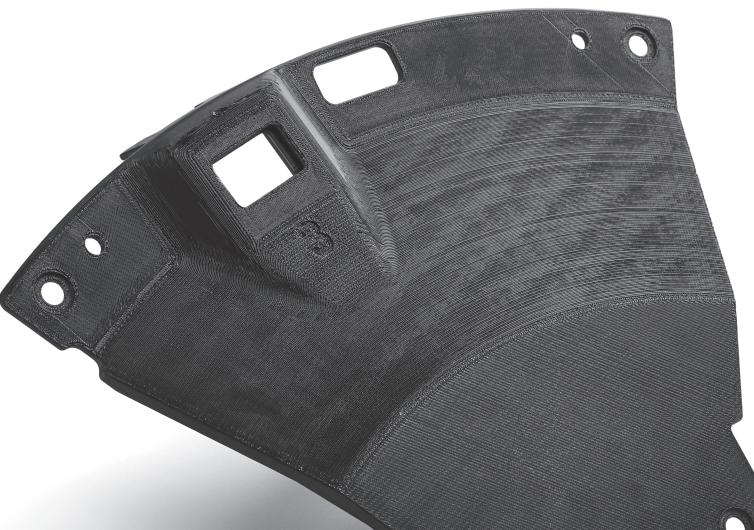
7 minute read
Foster Ferguson, Director of Aerospace, Stratasys
Stratasys joins forces with Lockheed Martin to qualify a space-ready filament material
Stratasys, one of the world’s largest 3-D printing companies, is providing baseline material qualification data for Antero 840CN03 filament materials. These materials offer the strength as well as the heat and chemical resistance necessary for additively manufactured parts such as those fabricated for the Orion Crew Module space capsule designed and built by Lockheed Martin. Foster Ferguson, Director of Aerospace for Stratasys, explains how this project impacts future satellite and spacecraft manufacturing efforts.
Crispin Littlehales, Global Contributing Editor, Satellite Evolution Group
Question: How did this project with Lockheed Martin come about and how is it progressing?
Foster Ferguson: Stratasys and Lockheed Martin have a deep partnership that has evolved over many years. We work with several divisions, but this project is all about the demands that come with making parts for the space industry. Antero 840CN03 is a material that Stratasys developed specifically for Lockheed and the space industry a few years ago. It is a blended and functionalized PEKK-based high-performance ESD thermoplastic composite material developed specifically for productiongrade Stratasys FDM® 3D printers that meets ESD performance and NASA outgassing requirements. It also exceeds the flame, smoke, and toxicity (FST) characteristics required for aviation applications. We have also done testing from a fatigue standpoint and the data tells us that Antero 840CN03 has about three and a half times greater fatigue resistance than other printed materials. These characteristics are key to Lockheed which used the material on a Stratasys F900® printer to create the hatch cover for the Orion spacecraft.
Whenever we develop a new material for our additive manufacturing platform, we take a holistic look at the industry in which the material will function. We consider all the variables to ensure that the new material has the performance, reliability, and repeatability that has earned Stratasys its reputation for excellence over the last 30 years. The baseline material qualification project provides greater comfort and understanding of the material to the engineers who are now integrating additive manufacturing into their design processes. Working on this effort with Lockheed will enable them to push the horizon and take their manufacturing into the next realm.
Question: How did you go about collecting and qualifying the data? Foster Ferguson: During the first phase of qualification, a baseline set of data was collected by printing more than 280 test coupons in Antero 840CN03 on Stratasys Fortus® F900® 3D printers at Lockheed Martin in Littleton, Colorado, and Stratasys Direct Manufacturing in Belton, Texas. Coupons were tested for tensile strength properties which is an important mechanical property for design. Data collected confirmed the high performance of the Antero material as well as the consistent mechanical properties which have been previously shown in academic studies. We needed to rely on people who understood the process and could develop a full test matrix including parameters such as testing conditions, coupon quantities and traceability.

Orion Hatch PEKK cover. Photo courtesy Stratasys
We can’t just commercialize the material and expect people to trust it without being able to back up our claims. Therefore, we are public about our data. We want our users to adopt the material and have competency as they push for optimum performance levels. We also wanted to make sure that the material was in compliance with both the National Center for Advanced Materials Performance and the National Institute for Aviation Research.
Question: What are the advantages of using 3D printing in the satellite and space industry?
Foster Ferguson: When you are trying to develop components for spacecraft, you need to complete your project in a timely fashion so that you can get to market first, and global supply chain issues are a very real impediment. If you can produce what you need locally, on the manufacturing floor, and not have to depend on suppliers, it saves a tremendous amount of time. For example, I recently visited a customer that was able to build a supersonic plane and get it to market within 18 months. Such an accomplishment would have been impossible without additive manufacturing.
It is also quite a bit more expensive if you are paying someone else to design and create customized components. Having that capacity organically is a gamechanger. You can imagine how important this is for government entities such as the Department of Defence and the National Labs which are trying to develop equipment to help advance our strategic positioning in the world.
We recently acquired Origin, a San Francisco-based company pioneering a new approach to the additive manufacturing of production parts using programmable photopolymerization to precisely control light, heat, force, and other variables to produce some of the toughest and most resilient materials in additive manufacturing. We’ve also created partnerships with other companies and introduced GrabCAD print software for our H350 3D printers to enable two-way connectivity and enterprise-wide applications.

Panel on the Orion hatch
Think about what’s involved in the manufacturing process. There are so many steps that go into creating the prototypes, the jigs, fixtures, and components that are necessary to create your final part or product. Using our technology, it’s possible to design, iterate and customize rapidly. We are at an inflection point right now. New technologies, materials, and qualification data are all key components of adoption integration. Then, too, as more of our 3D printers are being used in universities and community colleges, we’re also seeing the additive manufacturing workforce evolve.
Question: How and why did you involve Metropolitan State University (MSU) Denver in the baseline material qualification data project?
Foster Ferguson: Both Lockheed and Stratasys have a long-standing relationship with MSU Denver, and their engineering students use one of our F900 printers. We wanted to be very objective in the gathering of the data so we needed a couple of different locations and an independent academic institution to publish the data so that it would be impartial. In addition, when we want that data to become public to allow others to adopt the material specification or the process specification, then MSU Denver is in a position to enable that.
It’s a mutually beneficial arrangement. MSU Denver is in the proximity of many aerospace companies that use additive manufacturing. Those users put a lot of emphasis on workforce development so the engineers that are coming out of MSU Denver have a great deal of competency when it comes to 3D printing space-ready materials.
Question: Are there other players in the satellite and space industry who use your technology?
Foster Ferguson: Every big name in the industry is probably connected to Stratasys in one way or another. When you use our systems, you are printing in an enclosed build chamber which can be controlled to the tolerances that the space industry requires. Repeatability is another factor that makes our systems attractive; you can perform the exact same process on a different machine in another location and maintain absolute accuracy. If you look inside any vessel being sent into space, you’ll see a huge range of parts and non-structural things such as connectors to electrical housing, cable guides, and panelling—really the whole gamut. The name of the game is finding out how to accelerate production without sacrificing integrity.
We recognize the industry growth, and we intend to commit a lot of resources and collaboration efforts to work with satellite and space companies to deliver reliability, repeatability, accuracy, and speed. Satellites are very customized. Instead of cutting up a block of aluminium, or having something cast, you can 3D print everything inhouse. You can test it quickly and adjust whatever you need. What’s more, local sourcing adds resiliency to the supply chain.








